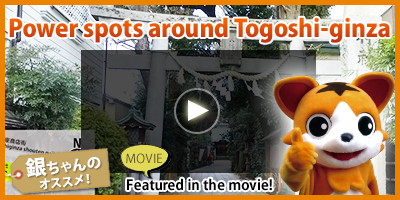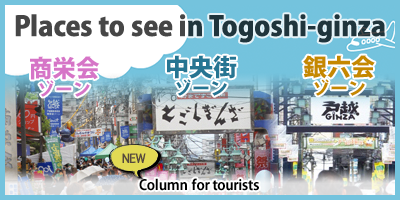About Us
Togoshi Ginza Shopping District Profile
The Togoshi Ginza Shopping District Cooperative Association (below, Togoshi Ginza Shopping District) is one of the leading shopping districts in the Kanto region, extending a total length of 1.3km adjacent to Togoshi Ginza Station on the Tokyo Ikegami Line, and is composed of the promotional associations for Togoshi Ginza Shoeikai Shotengai, Togoshi Ginza Shotengai, and Togoshi Ginza Ginroku Shotengai. With more than 400 businesses lining the shopping street, there are still many shops dealing in fresh meat, fish and produce, and it caters mainly to locals shopping for daily necessities.
The cluster of businesses that formed the foundation for the modern Togoshi Ginza shopping district is said to have come about from the gathering of merchants from downtown Tokyo, which suffered devastating damage from the Great Kanto Earthquake of 1923, and the areas near Yokohama who saw opportunities in this manufacturing district around Osaki, which was undergoing remarkable growth at the time. The opening of Togoshi Ginza Station on the Tokyo Ikegami Line in 1927, also led to the shops that had previously been scattered about the neighborhood to concentrate around the station.
Due to the area’s convenient transport access, with the Toei Togoshi Asakusa Station, JR Osaki Station, and Tokyu Oimachi Line Togoshi Park Station all within walking distance in addition to the Tokyo Ikegami Line, as well as the ability to do shopping on the way home and bright streetlights that make it safe even at night, it is also an extremely popular residential area frequently ranking among the most desirable neighborhoods.
While there seemed to be no end in sight to the prosperity of Togoshi Ginza during the economic boom years, the number of customers declined significantly in the immediate aftermath of the collapse of the economic bubble. However, the three shopping districts collaborated on a variety of revitalization projects, and as a result bring in more than 10,000 customers every weekday, with the trend in customer numbers in recent years continuing to rise.
The various projects to revitalize the shopping district have been praised, including the Togoshi Ginza Brand Project, which pioneered the type of shopping district branding and store-exclusive branding projects now implemented by shopping districts all over Japan, and the Togoshi Ginza Croquette Promotion Project, which has gained attention as a successful case of industry-university collaboration. It was listed among the Small and Medium Enterprise Agency’s “New 77 Striving Shopping Districts” released in June 2009, and received the grand prize in Nikkei Shimbun’s “13th Energetic Town Awards” (judging 142 shopping districts in the wards of Meguro and Shingawa) in 2012.
The Togoshi Ginza shopping district’s vibrant working-class atmosphere has drawn considerable attention from the media and other quarters, and the Togoshi Ginza Croquette promotion, riding the wave of the B-class gourmet and working-class gourmet trends, garnered coverage in many magazines and TV programs calling the area a “street food hotspot” and the “holy land for working-class gourmet”, greatly increasing its name recognition nationwide.
Today, in addition to travel agencies putting together guided shopping district tours for tourists, a rapidly growing number of visitors from the surrounding area come not only to shop, but to enjoy the shopping district itself, particularly on weekends and holidays.
The Origins of the Togoshi Ginza Name
Walk west down the Togoshi Ginza shopping street, and it meets the centuries-old Nakahara-kaido Road. Reputed to have existed since the medieval period, this old road was the route by which Tokugawa Ieyasu entered Edo.
There are various theories as to the origin of the place name Togoshi, one of which is that when traveling from Edo, beyond what is now Togoshi one entered Sagami Province (currently making up much of modern Kanagawa Prefecture), so it was called “Edo-goe no mura” (the village beyond Edo), and the name later became “Togoshi”. On the grounds of the Togoshi Hachiman Shrine, Togoshi’s local shrine, there is a stone monument inscribed with a poem praising the Joju-an for granting prayers: “Beyond Edo, atop Kiyomizu, at Joju-an not a day goes by with prayers unanswered.”
The Joju-an was a thatched hut that later gave rise to Togoshi Hachiman Shrine, and the Ippon Sugi Hachimangu Shrine in Hiratsuka is said to be its former site. The place name Kiyomizuzaka (Kiyomizu Slope), which comes from the “atop Kiyomizu” referred to in the poem, also survives to the present, and the old poem is still repeated among locals even today.
In addition to Kiyomizuzaka, there are many other place names which end with “zaka” around Togoshi Ginza, including Miyamaezaka, Hachimanzaka, Mitsuizaka, and Heiwazaka. The shopping district takes its form from the valley-like depression running east to west at the bottom of these hills, so it has extremely poor drainage, which caused it to be troubled by mud and flooding for many years.
Such was the case when the shopkeepers of the time heard that there was a problem with disposing of all the bricks left from the devastating damage to Ginza’s brick buildings in the Great Kanto Earthquake of 1923. With the aim of using the bricks to pave the poorly draining streets and make them easier to walk on, they pulled carts all the way to Ginza to get them. The origin of the name of Togoshi Ginza Ginroku Shotengai, easternmost part of Togoshi Ginza shopping district, is a fascinating story. Although the majority of the area was called Higashi Togoshi, or simply Togoshi, the bricks used to pave the street came from Ginza 6-chome, and so it was named Ginza 6-chome Shotengai.
Wanting not only to inherit the bricks from the original Ginza, the number one commercial district in Japan at the time, but also hoping to share in Ginza’s prosperity, they combined Togoshi and Ginza to coin the name Togoshi Ginza. While Togoshi Ginza is said to be the oldest of the more than 300 places across Japan that incorporate Ginza in their names, thanks to pedigree born of its link to the original Ginza, it is the true “namesake of Ginza.”
The Connection between Togoshi and Ginza
The entire areas of Ginza and Tsukiji were destroyed by the Great Ginza Fire of 1872. As a preventative measure against large-scale fires, the Meiji government encouraged the use of non-flammable building materials, and the Ginza townscape transformed into western-style brick buildings. One of the producers of bricks at the time was Shinagawa Shiro Renga Co., Ltd. As the company was located in Shinagawa Ward, the founder Katsuzo Nishimura heard of Togoshi Ginza’s troubles with poor drainage, linked it with Ginza’s brick disposal problem created by the earthquake, and proposed the idea of using those bricks to pave the streets of the shopping district. It is said that this was what led to the inheritance of the bricks from Ginza.
The Major Drain Construction Project
Today the utility lines are buried underground for attractive, up-to-date streets, but until the major drain (sewer) construction project in the 1950s, water overflowing from the gutters was reputedly the biggest problem facing the shopping district.






